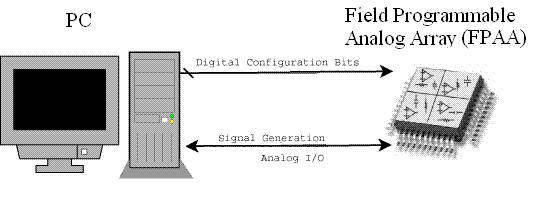Evolving a Control System on a Field Programmable Analog Array
Michael A. Terry & Una-May O'Reilly
Problem Statement
The first phase of this project will be the design and implementation of a novel Evolvable Hardware platform. This effort includes the design of Evolutionary Algorithms, which instantiate and implement candidate solutions in actual hardware. The device chosen for this platform is a recently developed commercial Field-Programmable Analog Array by Anadigm.[1] Using Genetic Programming, we can exploit the resources of this particular hardware device, while maintaining an independence from any particular chosen platform.
The second phase of this project will characterize the capabilities and limitations of our Evolvable Hardware platform to solve problems in the domain of Adaptive Controls. By allowing our platform to search for suitable controller designs, we intend to show that robust control can be acheived quickly, with minimal computing resources. We also intend to demonstrate the power of evolving controllers to adapt to unknown changes in the plant transfer functions of the systems to be controlled.

Figure 1: Evolvable Hardware Testbench
Motivation
Advances in the emerging field of Evolvable Hardware have demonstrated that a number of problems in electrical and systems engineering can be addressed through means of search. By allowing Genetic and Evolutionary Algorithms to find clever solutions within the design space, a programmer can acheive solutions that are expert-competitive and/or patentable using only a fraction of the design time and domain knowledge.[2]
Researchers in this field have used a number of hardware and software platforms to acheive their results. The capabilities of a number of evolvable hardware platforms have been evaluated in recent years, including JPL's Field Programmable Transistor Array(FPTA)[3], Field-Programmable Gate Arrays(FPGA)[4], SPICE Simulation[2], and Field Programmable Analog Arrays(FPAA)[5]. Many of these platforms are either expensive in terms of cost or computational resources, while others cannot be procured and deployed in real systems very easily. By incorporating knowledge from the problem domain into Genetic Programming, and using a commercial device, we intend to overcome many of these drawbacks. To the best of our knowledge, the evolvable hardware capabilities of the Anadigm FPAA have not been demonstrated in the literature, nor has Genetic Programming been applied to the analog circuit domain using actual hardware(instrinsic evolution).
Progress
A number of key developments have been made in the process of designing this evolvable hardware platform. First, a major problem in choosing commercial off-the-shelf(COTS) components for any system is that a designer must rely on product support from outside vendors. To address this, we have developed a representation to model hardware resources very generally, so that our evolutionary algorithms can take advantage of these components without a strict dependence on the platform of choice. This choice of a portable representation is very powerful, and allows us an opportunity to investigate the capabilities of artificial evolution on any number of platforms. Also, many reconfigurable chips can only be programmed through the manufacturers software interface. Through an agreement with the product vendor, we have been given able to gain true algorithmic control of the configuration of this device.
Future Work
We intend to investigate the limitations of this device to evolve adaptive controllers in a feedback loops. Also, a number of commercial reprogrammable hardware chips have been introduced recently. Many of these platforms provide mixed digital and analog functionality, and may provide a rich set of resources to evolutionary algorithms.
References:
[1] Anadigm AN221E04 Product Datasheet. http://www.anadigm.com/_doc/DS030100-U006.pdf
[2] John R. Koza and Martin A. Kean and Matthew J. Streeter and William Mydlowec and Jessen Yu and Guido Lanz. Genetic Programming IV:Routine Human-Competitive Machine Intelligence. Kluwer Academic Publishers, 2003.
[3] Jorg Langeheine and Karlheinz Meier and Johannes Schemmel and Martin Trefzer. Intrinsic Evolution of Digital-to-Analog Converters Using a CMOS FPTA Chip. In The Proceedings of the 2004 NASA/DoD Conference on Evolvable Hardware, pp. 18-25, Seattle, Washington, USA, June 2004.
[4] Lukas Sekanina and Stepan Friedl. On Routine Implementation of Virtual Evolvable Devices Using COMBO6. In The Proceedings of the 2004 NASA/DoD Conference on Evolvable Hardware, pp. 63-70, Seattle, Washington, USA, June 2004.
[5] Garrison W. Greenwood and David Hunter and Edward Ramsden. Fault Recovery in Linear Systems via Intrinsic Evolution. In The Proceedings of the 2004 NASA/DoD Conference on Evolvable Hardware, pp. 115-122, Seattle, Washington, USA, June 2004.
The Stata Center, Building 32 - 32 Vassar Street - Cambridge, MA 02139 - USA tel:+1-617-253-0073 - publications@csail.mit.edu (Note: On July 1, 2003, the AI Lab and LCS merged to form CSAIL.) |
